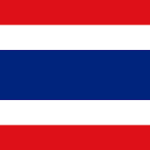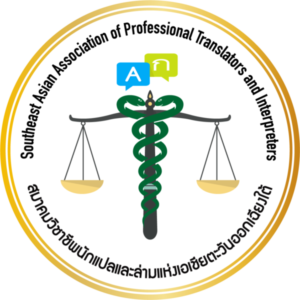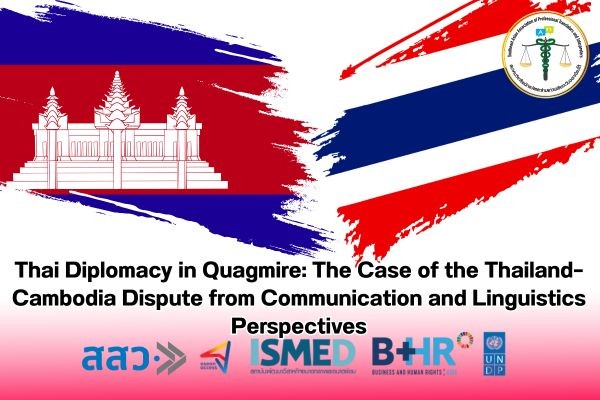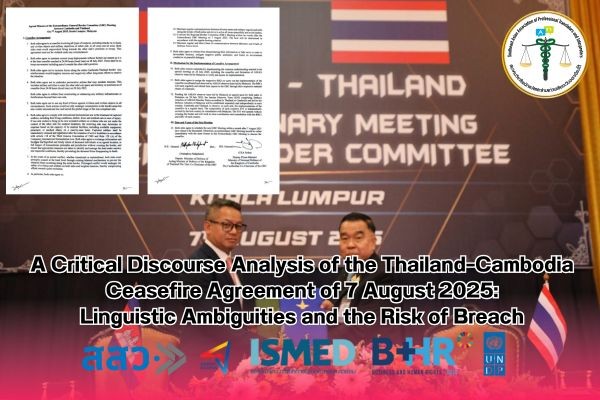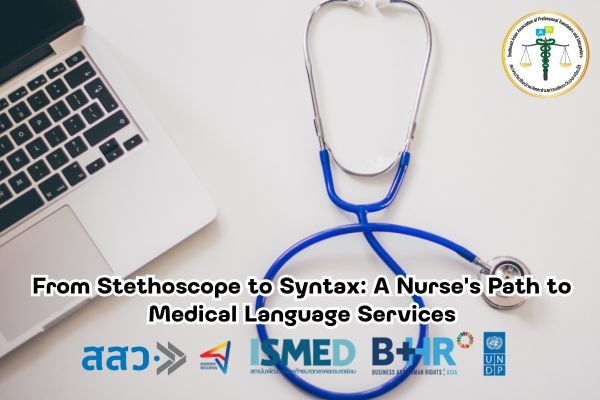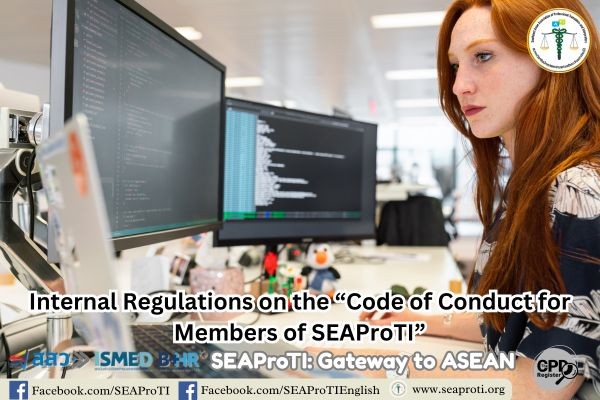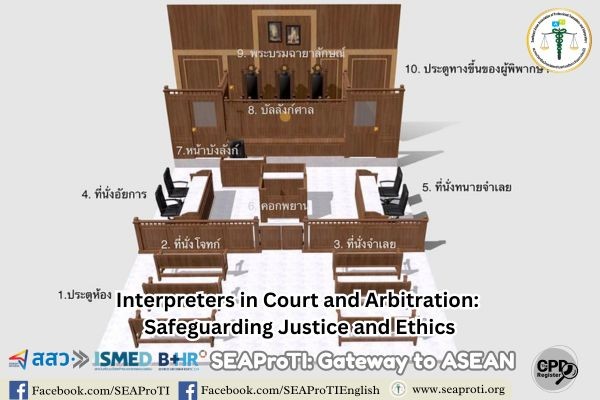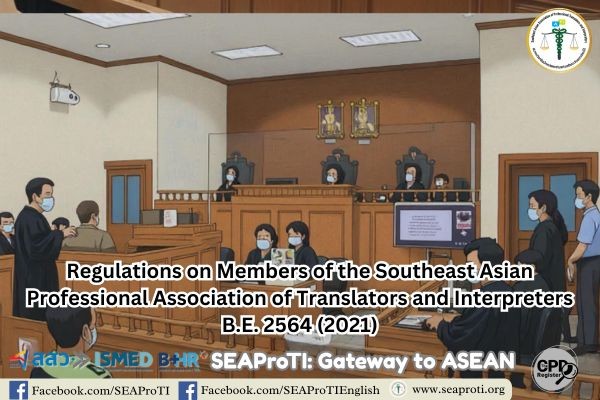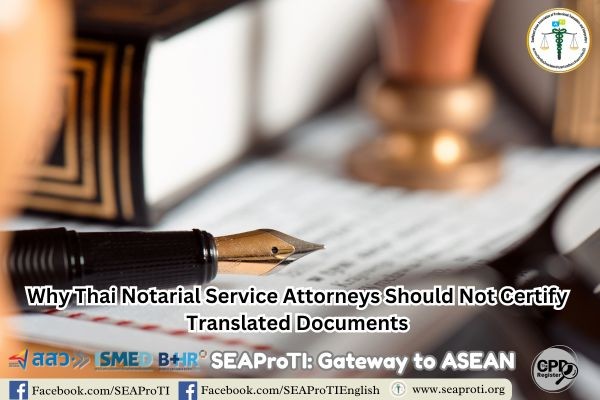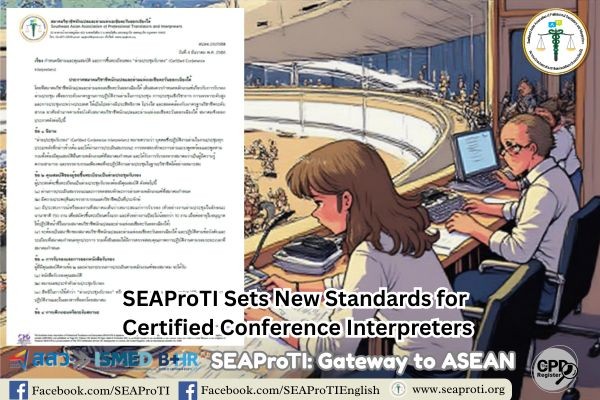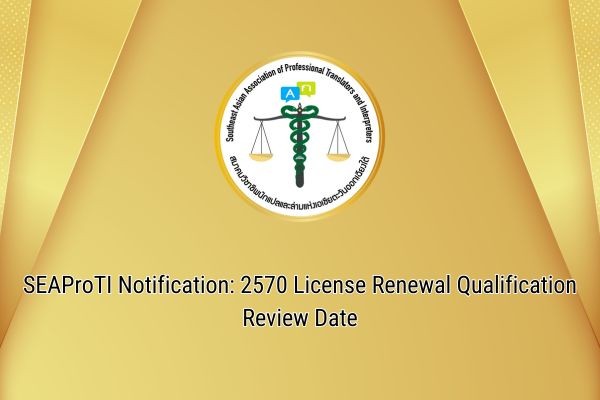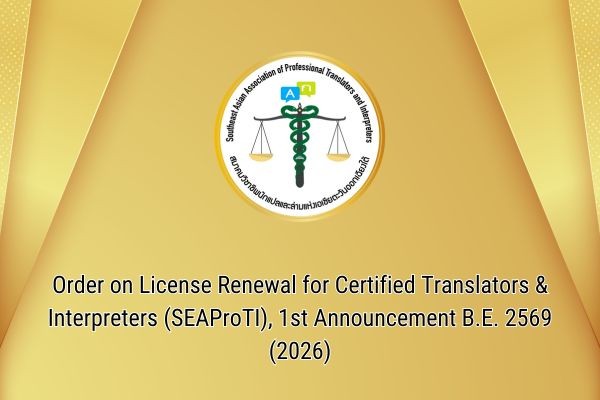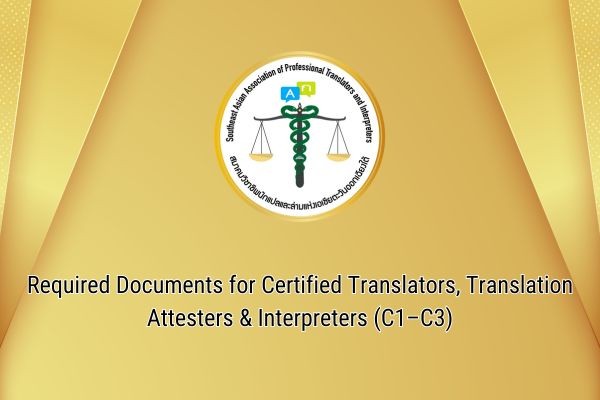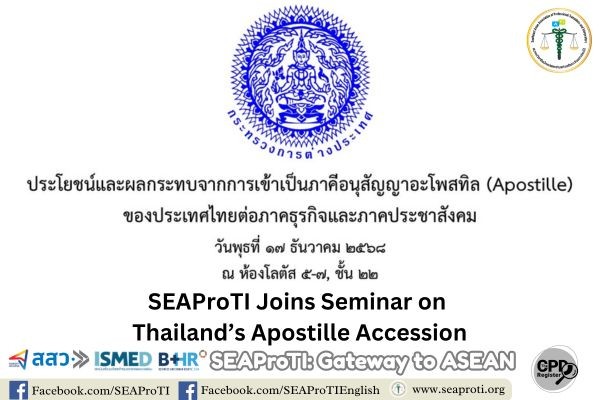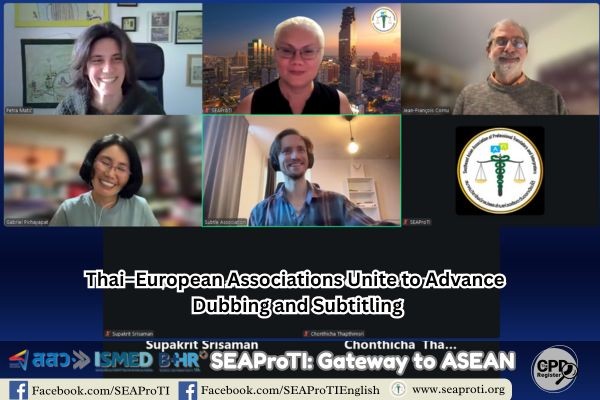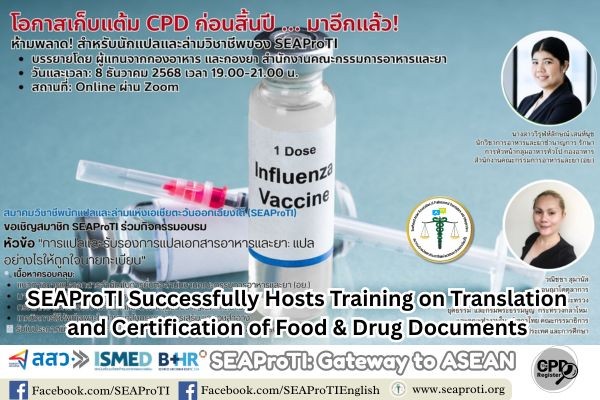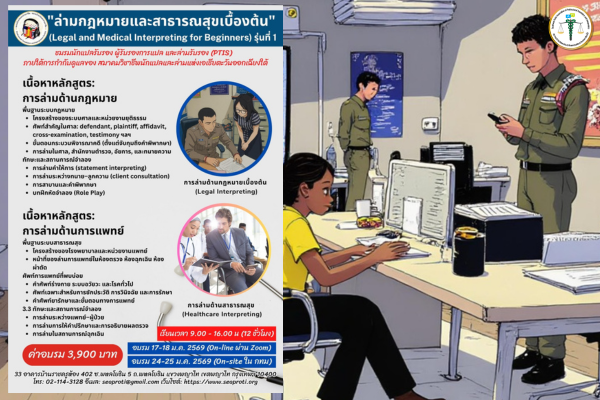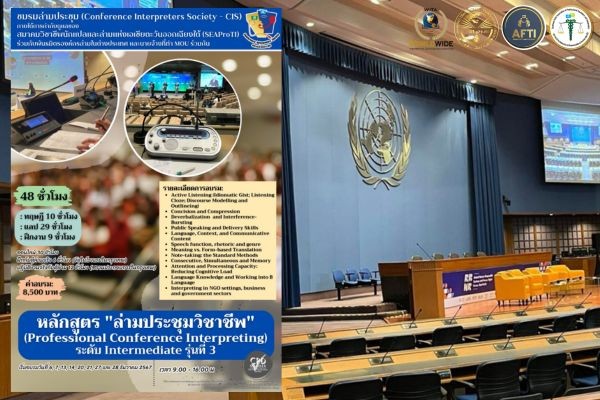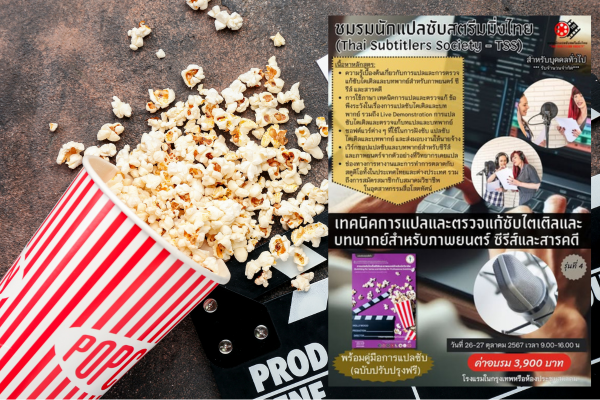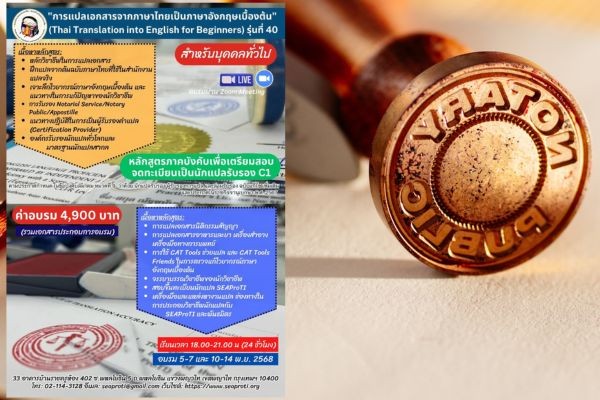Thai Diplomacy in Quagmire: The Case of the Thailand–Cambodia Dispute from Communication and Linguistics Perspectives
Author: Wanitcha Sumanat, the president of the Southeast Asian Association of Professional Translators and Interpreters
Introduction
The late-July flare-up on the Thai–Cambodian frontier led to five days of fighting, the displacement of hundreds of thousands, and a fragile ceasefire on July 29, 2025. Within two weeks, alleged landmine incidents reignited tensions and a blame game in the information domain. In parallel, Kuala Lumpur hosted an Extraordinary General Border Committee (GBC) meeting on August 7 that produced a 13-point joint statement detailing ceasefire modalities and third-party observation. The discursive battle—press briefings, spokesperson interventions, and newswire framing—became a principal arena of contestation over responsibility and legality.
This paper asks: How do linguistic strategies—speech acts, framing, politeness, and translation—shape the trajectory and perception of the 2025 dispute? It analyzes primary texts from Thai and Cambodian ministries and spokespersons, triangulated with international reportage.
Method and Frameworks
We draw on (i) speech-act theory to classify performative force in official utterances; (ii) framing to map narrative construction; (iii) politeness theory to detect face-work; and (iv) translation/terminology analysis to track semantic drift across Thai–Khmer–English. The corpus includes Thai MFA press briefings (July 27 & 29), Thai press releases (July 31), Cambodian MFAIC updates (Aug 7, Aug 12), Cambodian government spokesperson interventions (Aug 14), and international reporting (Reuters, AP, Al Jazeera, ASEAN statement).
The contest of frames
Thailand’s frame: Ceasefire compliance + lawful self-defense
Thai MFA texts after July 27 present a throughline: Thailand is committed to the ceasefire but compelled to respond when attacked. On July 29, the MFA wrote that despite efforts toward a ceasefire, “after 00.00 hrs. of 28 July 2025, Cambodian troops continued to launch attacks… In response, Thailand exercised its right to self-defense in a proportionate manner.” The coupling of compliance (cooperative face) with self-defense (legal face) frames Thai actions as reactive and legitimate.
The July 31 press release reiterates “strictly upholding the ceasefire,” a high-commitment lexical choice. The adverb “strictly” (สูงของ modality) signals normative high alignment and anticipates any reciprocal accusation.
Cambodia’s frame:
Cambodia’s August 7 and August 12 updates stress that the ceasefire “spared many lives” and that Cambodia adheres to obligations (Ottawa Convention), while casting doubt on Thai compliance and force placement. This narrative pairs humanitarian value with legal adherence, attributing violations to Thailand.
On August 13–14, Phnom Penh escalated its discursive defense: official channels and the government spokesperson rejected “baseless accusations” about newly laid mines and called on Thailand to respect the 13-point agreement and release 18 detained Cambodian soldiers—shifting the agenda from denial to counter-demnand (request + moral pressure).
International media’s frame:
Global outlets compress complexity into a succinct triad: fragile truce, landmines, mutual accusation. Reuters (Aug 12) emphasizes sequence (“another soldier injured”), location (near Ta Moan Thom), and the legal overlay (Ottawa Convention). The Associated Press highlights Thailand’s warning it may act in “self-defense,” foregrounding escalation risk. This headline compression amplifies threat perception and stalemate semantics (“fragile,” “another,” “blame”).
Speech-act calibration: “urge” vs. “demand,” “reject” vs. “condemn”
ASEAN’s July 27 ministerial statement “deeply concerned” and “urge” language exemplifies regional face-saving: expressives + directives with mitigated force. Compare this to Thai “exercise its right to self-defense” (assertive + commissive implication) and Cambodia’s “rejects baseless accusations” (assertive with metapragmatic denial). The illocutionary force differences shape expectations: urge invites voluntary compliance; self-defense justifies unilateral measures; rejects forecloses concession without evidence exchange.
At the spokesperson level, Thailand’s army cites “evidence” of PMN-2 mines and calls for Ottawa compliance, while Cambodia’s Pen Bona repeats adherence and problematizes Thai troop placement. The pair function as dueling assertives, each presupposing facts and assigning burden of proof to the other.
Lexical choices and legal framing
Ceasefire vs. truce
Thai and Cambodian texts use ceasefire (legal-administrative register), while international reports often opt for truce (journalistic register with connotations of fragility). Ceasefire indexes formal compliance architecture (13 points, observers), whereas truce colloquially frames it as temporary and brittle—predisposing audiences to expect violations. The GBC joint statement’s wording (weapons prohibition, non-reinforcement) aligns with ceasefire’s formalism.
Self-defense and proportionality
Thai MFA’s invocation of proportionate self-defense imports jus ad bellum vocabulary into press briefings, translating battlefield events into legal categories for international audiences and third-party arbiters (UN, ASEAN, US). The US Embassy’s messaging synchronizes the legal frame by urging protection of civilians and cessation of attacks—reinforcing a compliance lens over a bilateral blame lens.
Newly laid mines vs. war remnants
Reuters and Thai army communications highlight “new landmines” (PMN-2), mapping the issue onto Ottawa Convention violations; Cambodia counters that casualties result from remnants and routing deviations—two counter-frames that neutralize moral culpability by appealing to uncertainty and operational error. The lexical contrast (“newly laid” vs. “remnants”) is decisive: one attributes agency; the other, legacy hazard.
Politeness, face-work, and indirectness
Thai MFA texts emphasize commitment + restraint, a positive-politeness strategy for multiple audiences (domestic, ASEAN, UN). The formula “strictly upholding” + “proportionate” softens the face-threatening act of justifying force. Cambodian communications, while often formal and courteous, adopt negative-politeness toward third parties (legal fidelity, humanitarian cost) and bald-on-record rebuttal toward Thai allegations (“rejects baseless accusations”). The asymmetry arises from positional needs: Bangkok seeks to show control and legal prudence; Phnom Penh seeks to disconfirm blame and shift the agenda to Thai obligations (e.g., release of 18 soldiers).
Translation and terminology drift
Thai → English
Key Thai terms include “ยึดมั่นในข้อตกลงหยุดยิง” (“adhere strictly to the ceasefire”) and “ป้องกันตนเองอย่างได้สัดส่วน” (“proportionate self-defense”). When rendered into English for press notes, “strictly upholding” and “proportionate” carry stronger legalistic force than everyday Thai might convey to domestic audiences, strategically aligning with international legal discourse.
Khmer → English
Cambodian updates frequently use “adhere/strictly adhere” and “reject baseless accusations.” In Khmer-origin communications, terms like “គោរព” (to respect/observe) and “បដិសេធ” (to reject) are routinely translated as adhere and reject, which in English map to high-commitment modal verbs—minimizing room for nuanced hedging. The result is assertion stacking: adherence claims, humanitarian appeals, and counter-allegation denials in one paragraph.
Ambiguity around “disputed territory”
Thai usage of “พื้นที่ทับซ้อน” (“overlapping area”) is softer than disputed territory, which in English connotes a more formal bilateral dispute under international law. Cambodian English texts prefer border area, sometimes avoiding the pragmatic concession entailed by “disputed.” Translational asymmetry thus reframes the map: overlap suggests technical demarcation issues; dispute invites third-party adjudication narratives. (Analytical inference aligned with publicly available phrasing in both governments’ English-language outputs.)
The Kuala Lumpur GBC joint statement: convergence text
The August 7 joint statement provides a lingua franca of de-escalation: ban on all weapons use, avoidance of unprovoked firing, and a commitment not to reinforce along the border. This text is performatively valuable because it creates shared terminology (ceasefire, non-reinforcement, observers)—terminological convergence that professional interpreters can stabilize across Thai, Khmer, and English in subsequent engagements.
Media mediation and escalation potential
International headlines distill complex exchanges into punchy contrasts—self-defense vs. denial, another mine vs. remnants. While necessary for fast audiences, this stylization may bias public understanding toward n-th violation narratives (“another”), fostering expectational pessimism that can box diplomats into harder lines. Yet newswire chronology also constrains post-hoc reframing: once “newly laid” circulates, later corrections struggle to overcome primacy.
Implications for interpreters and translators
- Term harmonization: Draft bilingual term sheets (Thai/Khmer/English) for ceasefire lexicon (e.g., non-reinforcement, unprovoked fire, proportionate response). Using the GBC text as anchor reduces drift in mixed briefings.
- Modality calibration: When rendering directives (urge/demand/call upon), preserve illocutionary force. Substituting urge with request under-translates strength; replacing call upon with demand over-translates and escalates.
- Evidence descriptors: Translate epistemic qualifiers faithfully—allegedly, reportedly, confirmed—to avoid evidential inflation (turning claims into facts). Newswire style guides can influence official paraphrase; professionals should resist drift toward categorical language when sources are mixed.
- Quote length discipline: Keep verbatim excerpts short across languages to prevent indexical re-framing (quoted snippets travel farther than nuanced paragraphs), while providing precise dates and loci for verification.
Conclusion
The 2025 Thailand–Cambodia crisis illustrates how language engineering is central to crisis management. Thailand’s twin frame of ceasefire compliance + proportionate self-defense and Cambodia’s pairing of adherence + denial/rebuttal show coherent but incompatible narratives. The August 7 GBC joint statement demonstrates that terminological convergence is possible, and where such convergence occurs, interpreters and translators can materially enhance de-escalation by stabilizing shared meaning across working languages. Aligning modality, preserving evidentials, and harmonizing key terms are not merely technical tasks; they are statecraft by other means.
The path out of the quagmire runs through language: calibrated speech acts, agreed frames, and disciplined translation. For future incidents, pre-agreed bilingual glossaries rooted in GBC language, coupled with real-time interpreter briefings and joint press templates, could reduce semantic drift and the perception-gap that so often fuels renewed confrontation.
Notes on textual evidence and quotes
To respect fair-use and ensure accuracy, short quotations were used sparingly and paraphrases were anchored to primary sources with dates. All statements cited are from July 27 to August 14, 2025, matching the period of active diplomatic communication and immediate post-ceasefire contestation.
References
- Al Jazeera. (2025, August 7). Cambodia and Thailand agree to deploy ASEAN ceasefire monitors.
- Al Jazeera. (2025, August 12). Thailand accuses Cambodia of planting landmines after soldier injured.
- Associated Press. (2025, August 8). Hundreds of Buddhist monks in Cambodia gather to praise ceasefire with Thailand and mourn the dead.
- Associated Press. (2025, August 12). Thailand warns it may act in ‘self-defense’ after soldier hurt by a mine blast near Cambodian border.
- ASEAN Foreign Ministers. (2025, July 27). Statement on Thailand–Cambodia border dispute. Ministry of Foreign Affairs, Malaysia.
- Cambodia MFAIC. (2025, August 7). Updates on the situation of the Cambodia–Thailand border (Part II).
- Cambodia MFAIC. (2025, August 12). Updates on the situation of the Cambodia–Thailand border.
- Khmer Times. (2025, August 13). Ministry of Foreign Affairs and International Cooperation rejects Thailand’s baseless accusations regarding recent landmine explosions and threats to Cambodia’s sovereignty.
- Nation Thailand. (2025, August 13). Thai Army rejects Cambodia’s denial of new landmines.
- Nation Thailand. (2025, August 14). Thai Army responds to Cambodia’s calls for action under ceasefire.
- Reuters. (2025, August 12). Thailand says another soldier injured by landmine near Cambodia.
- Royal Thai Government, Ministry of Foreign Affairs. (2025, July 27). Summary of press briefing on the Thai–Cambodia border situation.
- Royal Thai Government, Ministry of Foreign Affairs. (2025, July 29). Summary of press briefing: Update on the implementation of ceasefire.
- Royal Thai Government, Ministry of Foreign Affairs. (2025, July 31). Press release on the Thailand–Cambodia border situation.
- Royal Thai Government, Ministry of Foreign Affairs. (2025, August 7). Extraordinary Cambodia–Thailand General Border Committee (GBC) joint press statement.
- Xinhua. (2025, August 7). Thailand, Cambodia reach consensus on ceasefire details at extraordinary GBC meeting.
- U.S. Embassy Bangkok. (2025, July 25). On the Thailand–Cambodia border conflict (statement).
About Certified Translators, Translation Certification Providers, and Certified Interpreters of SEAProTI
The Southeast Asian Association of Professional Translators and Interpreters (SEAProTI) has published the criteria and qualifications for registering as “Certified Translators,” “Translation Certification Providers,” and “Certified Interpreters” of the Association under Sections 9 and 10 of the Royal Gazette, Secretariat of the Cabinet, Prime Minister’s Office, Kingdom of Thailand, dated 25 July 2024, Vol. 141, Part 66 Ng, p. 100. Full text available at: The Royal Thai Government Gazette
SEAProTI is the first professional association in Thailand and Southeast Asia with a formal certification system for Certified Translators, Translation Certification Providers, and Certified Interpreters.
Head Office: Baan Ratchakhru Building, No. 33, Room 402, Soi Phahonyothin 5, Phahonyothin Road, Phaya Thai Subdistrict, Phaya Thai District, Bangkok 10400, Thailand. Email: hello@seaproti.com Tel: (+66) 2-114-3128 (Office hours: Mon–Fri, 9:00–17:00)
การทูตไทยติดหล่ม: กรณีพิพาทไทย–กัมพูชา ในมุมมองการสื่อสารและภาษาศาสตร์
ผู้แต่ง วณิชชา สุมานัส นายกสมาคมวิชาชีพนักแปลและล่ามแห่งเอเชียตะวันออกเฉียงใต้
ปลายเดือนกรกฎาคม 2568 เหตุปะทะชายแดนไทย–กัมพูชาปะทุขึ้นอีกครั้ง ทำให้มีการสู้รบหลายวัน ชาวบ้านหลายหมื่นต้องอพยพ และในวันที่ 29 กรกฎาคม มีการตกลงหยุดยิงชั่วคราว แต่ไม่นานก็เกิดเหตุระเบิดจากทุ่นระเบิด จนทั้งสองฝ่ายกล่าวหากันว่าละเมิดข้อตกลง ขณะเดียวกัน เมื่อวันที่ 7 สิงหาคม คณะกรรมาธิการชายแดนทั่วไปไทย–กัมพูชา (GBC) ประชุมที่กรุงกัวลาลัมเปอร์ และออกแถลงการณ์ 13 ข้อ เพื่อยืนยันมาตรการหยุดยิงและการส่งผู้สังเกตการณ์
คำแถลงของรัฐบาลทั้งสองประเทศ กลายเป็นสมรภูมิอีกแห่งหนึ่งที่ต่างฝ่ายใช้เพื่อเล่าเรื่องของตนเอง ปกป้องภาพลักษณ์ และดึงความเห็นจากประชาคมโลก
บทความนี้ใช้กรอบคิด 4 ด้าน ได้แก่
- วัจนปฏิบัติ (Speech Acts) – วิเคราะห์ว่าแต่ละข้อความทำหน้าที่อะไร เช่น การขอร้อง การประกาศ การโต้แย้ง
- การสร้างกรอบความหมาย (Framing) – ดูว่าฝ่ายไทยและกัมพูชาวางเรื่องราวอย่างไรให้เข้าทางตน
- กลยุทธ์รักษาหน้า (Politeness) – การใช้ถ้อยคำลดแรงปะทะหรือเน้นความสุภาพ
- การแปลและความคลาดเคลื่อนทางความหมาย – การถ่ายทอดจากไทย–เขมร–อังกฤษที่อาจเปลี่ยนน้ำหนักหรือความหมาย
กรอบของไทย: “ปฏิบัติตามหยุดยิง + ป้องกันตนเองอย่างชอบธรรม”
- หลังวันที่ 27 กรกฎาคม กระทรวงการต่างประเทศไทยเน้นว่าประเทศไทยยังคงปฏิบัติตามข้อตกลงหยุดยิง แต่จำเป็นต้องตอบโต้เมื่อถูกโจมตี โดยใช้คำว่า “ป้องกันตนเองอย่างได้สัดส่วน” เพื่อชี้ว่าการใช้กำลังเป็นไปตามสิทธิและกฎหมายระหว่างประเทศ
- กัมพูชาเน้นว่าการหยุดยิงช่วยรักษาชีวิตคน และตนเองปฏิบัติตามอนุสัญญาออตตาวา (ห้ามใช้ทุ่นระเบิด) พร้อมปฏิเสธข้อกล่าวหาจากไทยเรื่องทุ่นระเบิดใหม่ และหันไปเรียกร้องให้ไทยปฏิบัติตามข้อตกลง 13 ข้อ รวมถึงปล่อยทหารกัมพูชาที่ถูกควบคุมตัว
กรอบของสื่อต่างประเทศ: “หยุดยิงเปราะบาง + ระเบิดกับข้อกล่าวหาสวนกันไปมา”
- สำนักข่าวต่างประเทศสรุปสถานการณ์สั้น ๆ ว่าเป็นการหยุดยิงที่เปราะบาง มีเหตุทุ่นระเบิด และมีการกล่าวโทษกันไปมา การใช้คำอย่าง “fragile truce” หรือ “another blast” ทำให้ผู้อ่านรู้สึกว่าสถานการณ์พร้อมปะทุอีกครั้ง
น้ำหนักของคำ: “ขอให้” vs. “เรียกร้อง” / “ปฏิเสธ” vs. “ประณาม”
แถลงการณ์ของอาเซียนใช้คำว่า “ขอให้” (urge) ซึ่งเป็นถ้อยคำเชิงขอร้องมากกว่าบังคับ ต่างจากคำของฝ่ายไทยที่เน้นสิทธิการป้องกันตนเอง หรือฝ่ายกัมพูชาที่ใช้ “ปฏิเสธข้อกล่าวหาที่ไม่มีมูล” ซึ่งเป็นการตัดบทชัดเจน
การเลือกคำและกรอบทางกฎหมาย
- “หยุดยิง” กับ “พักรบ” – “หยุดยิง” ฟังเป็นทางการ มีข้อตกลงรองรับ ขณะที่ “พักรบ” ฟังเป็นเพียงชั่วคราวและไม่ผูกพันมาก
- “ป้องกันตนเองอย่างได้สัดส่วน” – เป็นภาษากฎหมายระหว่างประเทศ (jus ad bellum) ที่ไทยใช้เพื่ออธิบายการใช้กำลัง
- “ทุ่นระเบิดที่เพิ่งถูกวาง” กับ “ทุ่นระเบิดที่หลงเหลือจากอดีต” – คำแรกชี้ตัวผู้กระทำชัดเจน ส่วนคำหลังโยนให้เป็นเรื่องของซากสงครามโดยไม่เจาะว่าใครวาง
กลยุทธ์ความสุภาพและการรักษาหน้า
ฝ่ายไทยพยายามสื่อสารว่ามีความมุ่งมั่นและใช้ความยับยั้งชั่งใจ เพื่อรักษาภาพลักษณ์ในเวทีอาเซียนและประชาคมโลก ส่วนกัมพูชาใช้ถ้อยคำสุภาพเมื่อพูดถึงบุคคลที่สาม แต่เมื่อโต้แย้งไทยก็ใช้คำตรงไปตรงมาเพื่อปกป้องตนเอง
การแปลและความคลาดเคลื่อนทางความหมาย
- ไทย → อังกฤษ – คำว่า “ยึดมั่น” แปลเป็น “strictly uphold” ทำให้ฟังดูเข้มข้นและมีน้ำหนักทางกฎหมายมากขึ้น
- เขมร → อังกฤษ – คำว่า “គោរព” แปลเป็น “adhere” และ “បដិសេធ” แปลเป็น “reject” ซึ่งในภาษาอังกฤษเป็นคำที่ฟังดูหนักแน่นและไม่เปิดช่องมาก
- “พื้นที่ทับซ้อน” กับ “disputed territory” – “พื้นที่ทับซ้อน” ฟังดูเบากว่า เหมือนแค่รอการปักปันเขตแดน ขณะที่ “disputed territory” เป็นถ้อยคำที่ยอมรับว่ามีข้อพิพาทอย่างเป็นทางการ
แถลงการณ์ร่วมที่กัวลาลัมเปอร์: พื้นที่กลางของภาษา
แถลงการณ์ 13 ข้อของ GBC มีคำสำคัญที่ทั้งสองฝ่ายยอมรับ เช่น “หยุดยิง” “ไม่เสริมกำลัง” “หลีกเลี่ยงการยิงโดยไม่มีเหตุ” การมีคำร่วมกันช่วยให้ล่ามและผู้แปลใช้เป็นมาตรฐาน ลดการตีความที่ต่างกัน
บทบาทของสื่อมวลชนต่อการยกระดับความขัดแย้ง
ข่าวต่างประเทศมักตัดเนื้อหาให้สั้นและใช้คำที่ชวนให้เห็นภาพความตึงเครียด เช่น “another blast” หรือ “fragile truce” แม้จะเข้าใจง่าย แต่ก็อาจทำให้ประชาชนเข้าใจสถานการณ์ว่าเปราะบางและมีโอกาสปะทุสูงกว่าความเป็นจริง
ข้อเสนอสำหรับล่ามและนักแปล
- ทำบัญชีคำศัพท์สามภาษา สำหรับคำที่เกี่ยวกับหยุดยิง เพื่อลดความคลาดเคลื่อน
- รักษาน้ำหนักของคำที่แสดงระดับการบังคับ เช่น “urge” “request” “demand”
- แปลคำบ่งชี้ความน่าเชื่อถือของข้อมูล เช่น “allegedly” “reportedly” “confirmed” ให้ตรงความหมาย
- คัดเลือกคำพูดที่นำเสนอให้สั้นและตรง เพื่อเลี่ยงการถูกตัดทอนจนความหมายเปลี่ยน
บทสรุป
กรณีพิพาทไทย–กัมพูชาในปี 2568 แสดงให้เห็นว่าภาษาเป็นเครื่องมือสำคัญของการทูต การใช้คำ การวางกรอบ และการแปลสามารถเปิดหรือปิดช่องทางการเจรจาได้ การสร้างคำศัพท์ร่วมที่ทั้งสองฝ่ายยอมรับ และการรักษาน้ำหนักของถ้อยคำระหว่างการแปล อาจช่วยลดความเข้าใจคลาดเคลื่อน และเป็นส่วนหนึ่งของการคลี่คลายความตึงเครียดในระยะยาว
อ้างอิง
- Al Jazeera. (2025, August 7). Cambodia and Thailand agree to deploy ASEAN ceasefire monitors.
- Al Jazeera. (2025, August 12). Thailand accuses Cambodia of planting landmines after soldier injured.
- Associated Press. (2025, August 8). Hundreds of Buddhist monks in Cambodia gather to praise ceasefire with Thailand and mourn the dead.
- Associated Press. (2025, August 12). Thailand warns it may act in ‘self-defense’ after soldier hurt by a mine blast near Cambodian border.
- ASEAN Foreign Ministers. (2025, July 27). Statement on Thailand–Cambodia border dispute. Ministry of Foreign Affairs, Malaysia.
- Cambodia MFAIC. (2025, August 7). Updates on the situation of the Cambodia–Thailand border (Part II).
- Cambodia MFAIC. (2025, August 12). Updates on the situation of the Cambodia–Thailand border.
- Khmer Times. (2025, August 13). Ministry of Foreign Affairs and International Cooperation rejects Thailand’s baseless accusations regarding recent landmine explosions and threats to Cambodia’s sovereignty.
- Nation Thailand. (2025, August 13). Thai Army rejects Cambodia’s denial of new landmines.
- Nation Thailand. (2025, August 14). Thai Army responds to Cambodia’s calls for action under ceasefire.
- Reuters. (2025, August 12). Thailand says another soldier injured by landmine near Cambodia.
- Royal Thai Government, Ministry of Foreign Affairs. (2025, July 27). Summary of press briefing on the Thai–Cambodia border situation.
- Royal Thai Government, Ministry of Foreign Affairs. (2025, July 29). Summary of press briefing: Update on the implementation of ceasefire.
- Royal Thai Government, Ministry of Foreign Affairs. (2025, July 31). Press release on the Thailand–Cambodia border situation.
- Royal Thai Government, Ministry of Foreign Affairs. (2025, August 7). Extraordinary Cambodia–Thailand General Border Committee (GBC) joint press statement.
- Xinhua. (2025, August 7). Thailand, Cambodia reach consensus on ceasefire details at extraordinary GBC meeting.
- U.S. Embassy Bangkok. (2025, July 25). On the Thailand–Cambodia border conflict (statement).
เกี่ยวกับนักแปลรับรอง ผู้รับรองการแปล และล่ามรับรองของสมาคมวิชาชีพนักแปลและล่ามแห่งเอเชียตะวันออกเฉียงใต้
สมาคมวิชาชีพนักแปลและล่ามแห่งเอเชียตะวันออกเฉียงใต้ (SEAProTI) ได้ประกาศหลักเกณฑ์และคุณสมบัติผู้ที่ขึ้นทะเบียนเป็น “นักแปลรับรอง (Certified Translators) และผู้รับรองการแปล (Translation Certification Providers) และล่ามรับรอง (Certified Interpreters)” ของสมาคม หมวดที่ 9 และหมวดที่ 10 ในราชกิจจานุเบกษา ของสำนักเลขาธิการคณะรัฐมนตรี ในสำนักนายกรัฐมนตรี แห่งราชอาณาจักรไทย ลงวันที่ 25 ก.ค. 2567 เล่มที่ 141 ตอนที่ 66 ง หน้า 100 อ่านฉบับเต็มได้ที่: นักแปลรับรอง ผู้รับรองการแปล และล่ามรับรอง
*สมาคมวิชาชีพนักแปลและล่ามแห่งเอเชียตะวันออกเฉียงใต้ เป็นสมาคมวิชาชีพแห่งแรกในประเทศไทยและภูมิภาคเอเชียตะวันออกเฉียงใต้ที่มีระบบรับรองนักแปลรับรอง ผู้รับรองการแปล และล่ามรับรอง
สำนักงานใหญ่: อาคารบ้านราชครู เลขที่ 33 ห้อง 402 ซอยพหลโยธิน 5 ถนนพหลโยธิน แขวงพญาไท เขตพญาไท กรุงเทพมหานคร 10400
อีเมล: hello@seaproti.com โทรศัพท์: (+66) 2-114-3128 (เวลาทำการ: วันจันทร์–วันศุกร์ เวลา 9.00–17.00 น.)
